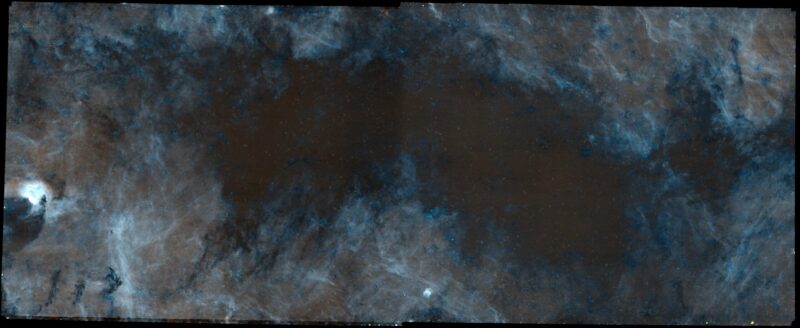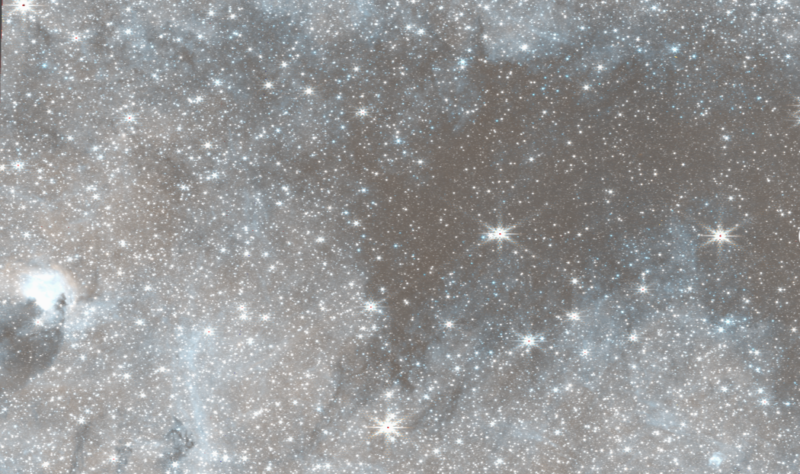
Toward the center of our Milky Way galaxy sits a dark cloud of gas and dust that astronomers say is behaving oddly. Astronomers call this region the Brick, because it’s a big block of dark material. Generally, great clouds of gas and dust like this one are actively forming stars from its raw materials. But the Brick has a surprisingly low rate of star formation. On December 4, 2023, the University of Florida said that the Brick’s inaction may be due to the large amount of frozen carbon monoxide they found there.
The international team of scientists published their peer-reviewed study in The Astrophysical Journal on December 4, 2023.
The 2024 lunar calendars are here! Best Christmas gifts in the universe! Check ’em out here.
More about the Brick
NASA describes the Brick like this:
One of the darkest infrared-dark clouds in our galaxy, this roughly brick-shaped cloud resides near the galaxy’s center, about 26,000 light-years from Earth. More than 100,000 times the mass of the sun, the Brick doesn’t seem to be forming any massive stars … yet. But it has so much mass in such a small area that if it does form stars, as scientists think that it should, it would be one of the most massive star clusters in our galaxy.
So, scientists have been puzzling over this cloud full of dense gas. It should be actively forming stars, but it’s not. Using the James Webb Space Telescope, a team of researchers, led by Adam Ginsburg of the University of Florida, peered into the Brick to find a large amount of carbon monoxide ice. While the researchers knew there was carbon monoxide ice in the cloud, they were surprised to see how much. Ginsburg said:
Our observations compellingly demonstrate that ice is very prevalent there, to the point that every observation in the future must take it into account.

Cold, but not cold enough
When you think of star formation, you probably think of heat, like a furnace turning on. And while that’s true, star formation begins in very cold conditions. Molecular clouds are extremely cold clumps of gas and dust just a bit above absolute zero. So, you’d think a large presence of frozen carbon monoxide would be a good thing to get star formation rolling in the Brick.
However, even with all the carbon monoxide ice, the Brick is still a bit warmer in temperature than other nearby nebulae. This result challenges what scientists know about gas clouds near the galactic center.
Previous observations were limited to seeing carbon monoxide as a gas, but the Webb telescope can see it in its solid, ice form. With a combination of the special filters on Webb and a little Photoshop to remove stars in the way, the researchers were able to get a better look at the Brick. As Ginsburg said:
We’re opening new paths to measure molecules in the solid phase (ice), while previously we were limited to looking at gas. This new view gives us a more complete look at where molecules exist and how they are transported.

More observations of the Milky Way’s center
Ginsburg and team are hoping to use Webb to take more observations of ices near the galactic center. They have more questions that will help them finally unravel the mystery of the Brick. Ginsburg said:
We don’t know, for example, the relative amounts of carbon monoxide, water, carbon dioxide and complex molecules. With spectroscopy, we can measure those and get some sense of how chemistry progresses over time in these clouds.
You can explore the Brick on your own with the visualization tool here.
Bottom line: There’s a dark region near the Milky Way’s center known as the Brick. This cold cloud of gas and dust should be forming stars, but, strangely, it’s not. The answer may lie in the abundance of carbon monoxide ice spotted there.
Source: JWST Reveals Widespread CO Ice and Gas Absorption in the Galactic Center Cloud G0.253+0.016











